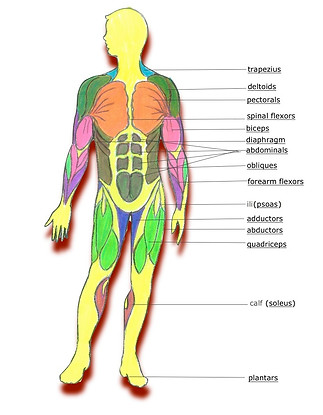

Body Works
How the Human Body Works
Since muscle groups are interconnected, a multi-level work-out is assured
every time we stretch. For example, when we stretch triceps, we strengthen
biceps; in releasing spinal extensors, we compact spinal flexors; and so on.
Chest opening postures enhance lung power by opening up the airways.
Postures involving back bends contract and tone spinal extensors in the
back of spine. They also open up pectorals, intercostals, and diaphragm
(which functions like an organ, but looks like a muscle).
Forward folds contract and strengthen spinal flexors in front of the spine.
Upper body compacting helps stretch trapezius and latissimus, while side
twists stretch psoas and tone the obliques as they help re-align the spine.
Abdominal massages enhance digestion, regulate bowel movement, and
maintain healthy functioning of regional glands and organs.
Upward arm stretches loosen rotator cuffs and strengthen the deltoids.
Backward arm stretches loosen biceps and tone the triceps. Forward leg
stretches mobilize the hip extensor, strengthen quadriceps, and stretch
hamstrings and calves; pelvic stretches release adductor muscles (inner
thigh), and strengthen the abductors outside the upper thigh.
Glands, Organs, and their Functions:
1. adrenal - controls water, mineral, glucose levels
2. brain - controls all other bodily functions
3. diaphragm - muscular organ dividing upper and lower regions of the abdominal area in front of the body
4. gall bladder - stores bile to break down the food
5. heart - purifies blood & pumps back to body
6. islet of Langerhans - its insulin level controls blood sugar
7. kidneys - renal organs that filter waste water
8. large intestine - retains fecal matter for waste removal
9. liver - its bile is stored in the gall bladder
10. lungs - respiratory organs directing air flow
11. pancreas - its juices aid in digestion of food
12. para-thyroid - controls calcium/ phosphorus
13. pineal - monitors sleep patterns/ of the mind
14. pituitary - its hormones control body growth
15. small intestine - absorbs nutrients/ minerals for distribution
16. spleen - regenerates/ stores/ filters blood
17. stomach - churns food ingested through mouth
18. thymus - its hormones build immune system
19. thyroid - controls metabolism with thyroxine
20. urinary bladder - releases waste water from body

Muscle Groups, and their Locations:
1. abdominal (abs) - front of waist
2. abductors - outer thigh
3. adductors - inner thigh
4. biceps - front of upper arm
5. cervix - back of neck
6. diaphragm - divides upper/ lower body
7. deltoids - shoulders
8. gastrocnemius - upper calf
9. gluteals (glutes) - buttocks
10. hamstrings - back of thighs
11. iliopsoas (psoas) - hip flexors
12. intercostals - muscles between ribs
13. latissimus (latts) - mid to lower back
14. obliques - sides of waist
15. pectorals (pects) - upper chest
16. plantars - arches/ soles of feet
17. popliteals - back of knees
18. quadriceps (quads) - front of thighs
19. sacrum - base of spine
20. soleus - lower calf
21. spinal extensors - back of spine
22. spinal flexors - front of spine
23. trapezius - back of shoulders
24. triceps - back of upper arms


